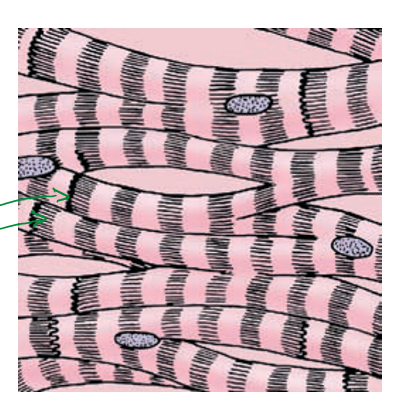BS 1: Membranes, Transport, Homeostasis & Tissues
1/76
There's no tags or description
Looks like no tags are added yet.
Name | Mastery | Learn | Test | Matching | Spaced |
|---|
No study sessions yet.
77 Terms
For a 30 year old 70 Kg male (avg male), what is the composition of fat, lean body mass and water?
18% fat
22% lean body mass
60% water
What is the split of numbers (in L) for total body water (TBW)?
Total body water (TBW) = 42L
TBW → intracellular fluid (ICF) = 25L
TBW → extracellular fluid (ECF) = 17L
What is the split of numbers for extracellular fluid (ECF) and for what fluids?
ECF → Interstitial fluid (ISF), plasma & Transcellular fluid
ISF = 13L
Plasma = 3L
Transcellular fluid = 1L
What is the definition of Transcellular fluid?
Any fluid that has crossed over an epithelial membrane
What are 6 examples of transcellular fluids?
Cerebrospinal fluid (brain)
urine (kidney & bladder)
gastrointestinal secretions (saliva, gastric juice, pancreatic juices, bile)
sweat
aqueous and vitreous humours (eye)
synovial fluids (joints)
True or False: the ionic composition between intracellular & extracellular fluid is the same.
FALSE u silly betch
the compositions are very different
intra has a lot less Cl- and Na+, and more K+ & protein
True or False: the osmolality in all fluid components other than transcellular is the same at 290mOsm, when at rest.
TRUEEEEE
True or False: the balance of ions in the interstitial fluid and blood plasma is very similar.
TRUEEEEE
they’re both extracellular fluids
Is there any protein in the blood plasma? if so how many mM?
Yes there is
1mM
Is there any protein in the interstitial fluid? if so how many mM?
#no
What is the main positive ion and main negative ion in the extracellular fluid?
main +ive ion = Na+
main -ive ion = Cl-
What is the main positive ion and main negative ion in the intracellular fluid?
main +ive ion = K+
main -ive ion = Cl-
but much less Cl- in intracellular, down to 20 mM from approx. 110 in extra.
Is there more or less protein in the intracellular fluid than the extracellular? by how much?
more protein
4mM(ICF) vs 1mM(ECF)
What is the barrier between the ICF and ISF?
Plasma membrane/cell surface membrane
What is the barrier between the ISF and transcellular fluid
Epithelium
What is the barrier between the ISF and plasma
endothelium
What are 3 features of the plasma membrane?
its phospholipid bilayer has high selective permeability e.g., impermeable to water based molecules
lots of transport proteins for uptakes and removal of specific solutes
vital for regulation of the intracellular environment
What is the phospholipid bilayer impermeable to?
what increases permeability of the membrane?
impermeable to ions and polar molecules
transporters/membrane proteins
How many different types of membrane proteins/transporters?
What are they?
3 types
Channels
carriers
pumps
What are the 2 categories of transporter?
Passive transport - driven by gradients e.g., Channels, carriers
active transport - ATP hydrolysis e.g., pumps
What are the 3 types of carriers? what does each one do?
Uniport/facilitator - moves one type of ion in one direction
Symport/co-transporter - moves two ions in the same direction, often opposite charges
Antiport/exchanger - takes one ion out and a dif ion in, usually of the same charge (+1/-1) to maintain electrical neutrality
what are 2 functions of transport proteins?
uptake of nutrients, substrates, cofactors, and export of waste products
regulation of intracellular ions (gradient maintenance), pH (acid & Base extrusion), cell volume (to prevent bursting, regulatory volume increase and decrease as water follows behind ion movement)
What generates a membrane potential?
what is the membrane potential at rest? (in mV)
the asymmetric distribution of K+ i.e., 120mM ICF vs 5mM ECF
this maintains an electrochemical conc gradient at approx -70 mV
What is water distribution across a cell determine by?
by OSMOSIS
water moves through aquaporins/passively following ions
at rest osmolality is the same, because water distributes itself so that the osmotic pressures are equal
What are 3 features of the capillary endothelium?
v. thin layer of cells lining blood vessels
highly permeable (leaky) in some organs (e.g., kidneys) and not others (e.g., brain)
important role in regulation of the interstitial fluid
What is water distribution across a capillary endothelium determined by?
hydrostatic pressure
colloid osmotic pressure (osmolality)
What are 3 features of the epithelia?
layers of cells covering internal and external surfaces of organs and tissues
has a protective/barrier function
important roles in absorption and secretion
what are 3 parts of the epithelial cell to remember?
apical membrane
basolateral membrane
tight junction
What are other names for the external and internal environment?
peripheral and core
What kind of fluctuations do you get in the external/peripheral environ?
large fluctuations in;
temp
diet
availabilty of water etc
What kind of fluctuations do you get in the internal/core environ?
small fluctuations in:
temp
pH [O2] [CO2]
[glucose]
blood pressure
What is the definition of Homeostasis?
maintenance of a constant environ in response to internal or external factors
What is negative feedback control?
Regulation of a system to maintain a controlled variable at its set point
set point - value/threshold that a variable should be maintained at to be healthy
it is a self-monitoring system
what are the basic steps of negative feedback?
change in variable
detection by receptor/sensor
sent to integrating centre (afferent pathway)
sent to effector system brings about correction of the variable (efferent pathway)
correction of variable detected at integrating centre so effector system stops
hence self-monitoring system
What are the steps for regulation of blood pressure via a negative feedback control system?
fall in blood pressure
baroreceptors (stretch sensitive in carotid arteries & aortic arch) detect change
sent via glossopharyngeal nerve to medulla oblongata (has control over cardiac system)
sent via autonomic nerves to the heart blood vessels
these increase cardiac output and vasoconstriction to return blood pressure to normal
What is a diurnal change in set point?
change in a set point over 24hr cycle
give an example of a diurnal change
e.g., body temp
body temp drops when sleeping
because not expending much energy relatively still
but when awake = moving, eating, metabolism speeds up
therefore temp increases, aiding in enzymes and kinetics
What is positive feedback control? give examples.
when the initial stimulus causes a response which reinforces itself
e.g., action potentials in nerves, ovulation, blood clotting
what are the 2 control systems?
nervous system
rapid (seconds)
short term effects
endocrine
slower (minutes to days)
long term effects
What are the divisions of the nervous system?
Nervous system
Central (CNS)
Peripheral (PNS)
CNS
Brain
Spinal Cord
PNS
autonomic nerves (involuntary)
parasympathetic - rest and digest
sympathetic - fight or flight
e.g., smooth & cardiac muscle, glands
somatic nerves (conscious control)
e.g., skeletal muscle
What is the basic pathway that the autonomic nerves take to the target cells?
preganglionic neuron (CNS) → postganglionic neuron (PNS) → target cell
List 5 comparisons of the sympathetic and parasympathetic systems
Sympathetic | Parasympathetic | |
|---|---|---|
Outflow from CNS | thoracic & lumbar parts of spinal cord | cranial & sacral part of spinal cord |
Preganglionic fibre length | short | long |
ganglionic transmitter | ACh (N2) | ACh (N2) |
ganglionic receptor | N2 receptor | N2 receptor |
postganglionic fibre length | long | short |
neuroeffector transmitter | Noradrenaline/norepinephrin (α or β) | ACh (M) |
postganglionic receptor | α and β adrenergic receptors | M - Muscarinic ACh receptor |
Effector tissues | smooth muscle, cardiaac muscle, gland | smooth muscle, cardiaac muscle, gland |
what are functional roles of the peripheral nervous system?
Both divisions innervate most organs and tissues
Often have opposing (antagonistic) effects
Sympathetic more active in stressful situations (‘flight or fight’ response)
Parasympathetic more active in vegetative situations (lectures…)
What flow of steps happen in the adrenal medulla for release of epinephrine/adrenaline?
sympathetic neuron from CNS synapses in adrenal medulla
releases ACh(N2)
binds to N2 receptor on a chromaffin cell
epinephrine secreted into circulation
Give examples of +ive & -ive feedback systems under hormonal control
-ive feedback = release of cortisol
Corticotrophin releasing hormone (CRH) released by hypothalamus
this stimulates release of adrenocorticotrophic hormone (ACTH) from pituitary gland
this stimulates high levels of cortisol release from liver
+ive feedback system = lactation
suckling on mammary gland
oxytocin released from posterior pituitary gland
milk released
loop broken when baby stops suckling (external break of loop)
What is the organisation of the body from smallest to largest?
cell - Fundamental structural and functional unit of the body
Tissue - A collection of cells that perform a particular function
Organ - Multiple tissues that perform a particular function by working together
System - A group of organs with a collective function
Organism - One complete individual
What are the 4 basic tissues?
Epithelia
Connective tissue
Muscle
Nervous
What is the definition of histology?
What does histology allow us to do?
The study of anatomy at the cellular level (and therefore tissues)
Knowing the histology of a structure allows you to work out its function
What are 3 places that epithelia can be found (generally)
Cover surfaces e.g., skin
lining cavities and tubes e.g., blood vessels
forming glands e.g., sweat & sebaceous glands
What are the 4 important characteristics of epithelia?
Attachment - cells adhere to each other, a basement membrane and nearby structures, this maintains integrity of the epithelial barrier
Avascularity - no blood supply, nutrients from other sources
Regeneration - epithelia are found in layers, cells underneath replace those above, e.g., skin
Polarity (apical & basal) - have top and bottom end
What is the basic structure of epithelial cells?
closely packed cells supported by a basement membrane/basal lamina
most epithelial linings are also supported by connective or another type of tissue

What are the 2 things that classification of epithelia is based on?
based on the number of cell layers & shape of cells
but in the most superficial (outermost) layer
What are the different number of cell layers, and the different shapes of epithelium called?
Number of cell layers:
simple - one layer
stratified - two or more layers
Shape:
squamous (flat, oval shaped nucleus)
cuboidal (cube, round shaped nucleus)
columnar (rectangular, oval-shaped, basally located nucleus)
What is the major function and common locations of simple squamous epithelium?
major function: exchange of nutrients and gases
location: blood vessels, alveoli
What is the major function and common location of non-keratinised stratified squamous epithelium?
major function: protection, barrier
location: oral cavity, oesophagus
i.e., found in places where the body is undergoing mechanical stress
What is the major function and common location of keratinised stratified squamous epithelium?
associated with keratin
major function: protection, waterproof barrier
location: skin
What is the major function and common location of simple cuboidal epithelium?
basally located nuclei
major function: absorption & secretion, often with surface modifications e.g., microvilli to increase SA
location: gastrointestinal tract

What is the major function and common location of pseudostratified ciliated columnar epithelium with goblet cells?
why is it called pseudostratified?
modifications: cilia & goblet cells
major function: mucociliatory escalator - mucus traps debris and cilia wafts it away
location: trachea and large respiratory airways
pesudostratified because appears to be stratified, as some cells don’t reach free surface, but actually all cells touch basement membrane
What are the 4 types of intercellular junctions?
Desmosomes
Hemidesmosomes
Tight Junctions
Gap Junctions
What is a desmosome? What is its function?
Very strong connections that join adjacent cells that resist stretching and twisting
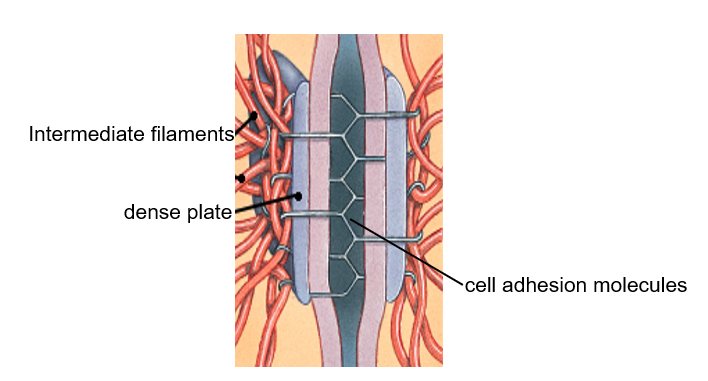
What is a hemidesmosome? What is its function?
Attach cells to the basement membrane thereby stabilising the position of the cell and anchoring the basal end of the cell to the underlying tissue
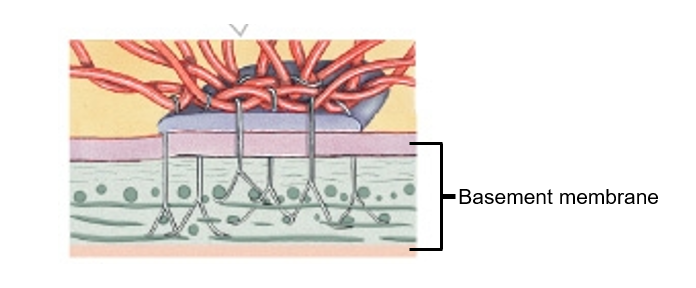
What are tight junctions? What is its function?
Located near the apical side of the cells
Adjacent cell membranes bound together by interlocking proteins
Prevents passage of water and solutes between cells
e.g. in digestive tract prevent digestive fluids passing between epithelial cells
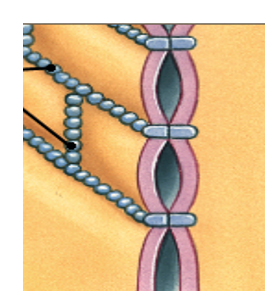
What are gap junctions? What is its function?
Interlocking membrane proteins (connexons) hold cells together
Connexons contain a central pore which allows movement of small molecules and ions between cells
Found in cardiac muscle
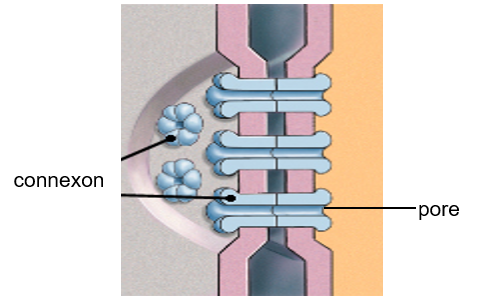
What are 6 functions of connective tissue?
Forms a structural framework for the body
Supports, surrounds and interconnects other tissue types e.g., abdominal cavity
Protects delicate organs
Transports fluids and dissolved materials
Stores energy reserves e.g., many connective tissues have adipose cells where energy reserves come from
Defends body from microorganisms e.g., lymphocytes within tissue
What does connective tissue consist of?
What are the 2 classifications of connective tissue?
Consists of cells within an extracellular matrix
specialised connective tissue
connective tissue proper
What type of cells are in the connective tissue?
fibroblasts; main cell type that synthesises the extracellular matrix
other cell types:
adipocytes
macrophages
mast cells
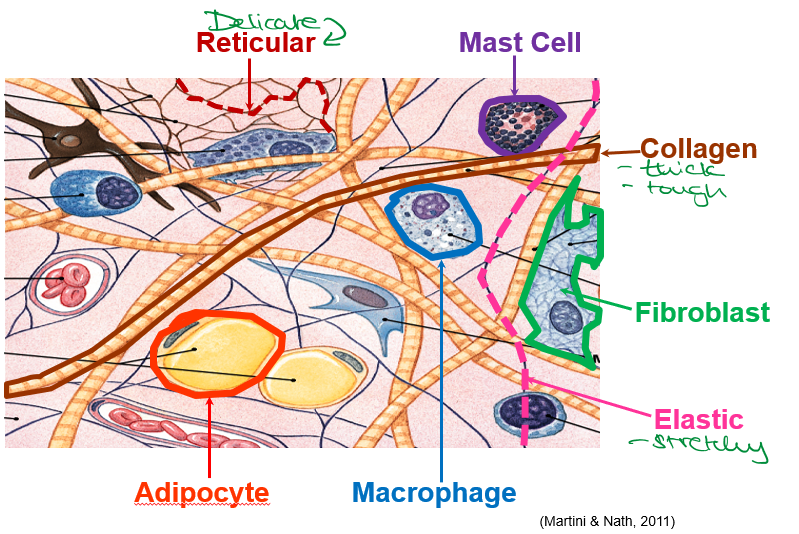
What are the 3 tissues fall under the specialised connective tissue classification and why?
Blood - watery EcM
Bone - tough EcM
Cartilage - jelly like EcM
they are all still connective tissues because they have an extracellular matrix (EcM), but just with different consistency
What 5 factors is the connective tissue proper classified by?
type
arrangement of fibres
abundance of fibres
cell types
ground substance
What are features of the loose areolar connective tissue? Where is this found?
Contains:
lots of ground substance
few fibres (collagen & elastic)
variety of cells
Fibroblasts
Adipocytes
Macrophages (transient)
Found under the epithelium that covers and lines the body surfaces
What are features of the dense irregular connective tissue? Where is this found?
Contains:
little ground substance
many collagen fibre bundles arranged haphazardly
few cells (mainly fibroblasts)
resists excessive stretching and distension
found in the dermis
What are features of the dense regular connective tissue? Where is this found?
Contains:
little ground substance
many densely packed bundles of collagen fibres arranged in parallel rows
few cells (mainly fibroblasts)
found in tendons and ligaments
What is the function of muscle tissue?
Produces movement and is specialised for contraction
What are the types of muscle tissue?
Skeletal
Smooth
Cardiac
What are 3 similarities between all type of muscle?
Elongated parallel to axis of contraction
Numerous mitochondria
Contractile elements
What are the functions and features of skeletal muscle?
Moves and stabilises the skeleton
Forms sphincters in digestive and urinary tracts
Involved in respiration
Long, cylindrical cells
Striated (striped dark & light bands)
Multinucleated
Innervated by somatic nervous system
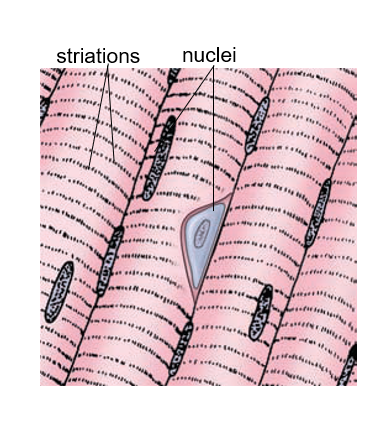
What are the functions and features of smooth muscle?
Located in the walls of organs, blood vessels and airways
Gastrointestinal movement
Alters diameter of airways and blood vessels
Short, fusiform cells
Non-striated
Single, centrally located nucleus
Innervated by autonomic nervous system

What are the functions and features of cardiac muscle?
Found in the heart wall
Helps to circulate blood & to maintain blood pressure
Branched muscle fibres
Striated (dark & light bands)
1-2 central nuclei
Intercalated discs
Innervated by the autonomic nervous system
